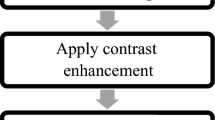Abstract
A common symptom of several pathologies is hyperemia, that occurs when a certain tissue has an abnormal hue of red. An increase of blood flow causes the engorgement of blood vessels, which produces the coloration. Hyperemia is an important parameter that specialists take into account when diagnosing diseases such as dry eye syndrome or problems derived from contact lenses wearing. In this work, we propose an automatic methodology to measure the hyperemia level of the bulbar conjunctiva. This methodology emphasizes the transformation from the extracted features to grading scales, using artificial neural networks for the process.
Access this chapter
Tax calculation will be finalised at checkout
Purchases are for personal use only
Preview
Unable to display preview. Download preview PDF.
Similar content being viewed by others
References
Bailey, I., Bullimore, M., Raasch, T., Taylor, H.: Clinical grading and the effects of scaling. Investigative ophthalmology & visual science 32(2), 422–432 (1991)
Baum, E.B.: On the capabilities of multilayer perceptrons. Journal of complexity 4(3), 193–215 (1988)
Canny, J.: A computational approach to edge detection. IEEE Transactions on Pattern Analysis and Machine Intelligence 6, 679–698 (1986)
Efron, N., Morgan, P.B., Katsara, S.S.: Validation of grading scales for contact lens complications. Ophthalmic and Physiological Optics 21(1), 17–29 (2001)
Gardner, M., Dorling, S.: Artificial neural networks (the multilayer perceptron)a review of applications in the atmospheric sciences. Atmospheric environment 32(14), 2627–2636 (1998)
Papas, E.B.: Key factors in the subjective and objective assessment of conjunctival erythema. Investigative ophthalmology & visual science 41(3), 687–691 (2000)
Park, I.K., Chun, Y.S., Kim, K.G., Yang, H.K., Hwang, J.M.: New clinical grading scales and objective measurement for conjunctival injection. Investigative ophthalmology & visual science 54(8), 5249–5257 (2013)
Park, J., Sandberg, I.W.: Universal approximation using radial-basis-function networks. Neural computation 3(2), 246–257 (1991)
Park, J., Sandberg, I.W.: Approximation and radial-basis-function networks. Neural computation 5(2), 305–316 (1993)
Rolando, M., Zierhut, M.: The ocular surface and tear film and their dysfunction in dry eye disease. Survey of Ophthalmology 45, Supplement 2(0), S203–S210 (2001). http://www.sciencedirect.com/science/article/pii/S0039625700002034
Schulze, M.M., Jones, D.A., Simpson, T.L.: The development of validated bulbar redness grading scales. Optometry & Vision Science 84(10), 976–983 (2007)
Sun, Y., Duthaler, S., Nelson, B.J.: Autofocusing algorithm selection in computer microscopy. In: 2005 IEEE/RSJ International Conference on Intelligent Robots and Systems, 2005. (IROS 2005), pp. 70–76. IEEE (2005)
Wolffsohn, J.S., Purslow, C.: Clinical monitoring of ocular physiology using digital image analysis. Contact Lens and Anterior Eye 26(1), 27–35 (2003)
Author information
Authors and Affiliations
Corresponding author
Editor information
Editors and Affiliations
Rights and permissions
Copyright information
© 2015 Springer International Publishing Switzerland
About this paper
Cite this paper
Sánchez, L., Barreira, N., Pena-Verdeal, H., Yebra-Pimentel, E. (2015). A Novel Framework for Hyperemia Grading Based on Artificial Neural Networks. In: Rojas, I., Joya, G., Catala, A. (eds) Advances in Computational Intelligence. IWANN 2015. Lecture Notes in Computer Science(), vol 9094. Springer, Cham. https://doi.org/10.1007/978-3-319-19258-1_23
Download citation
DOI: https://doi.org/10.1007/978-3-319-19258-1_23
Published:
Publisher Name: Springer, Cham
Print ISBN: 978-3-319-19257-4
Online ISBN: 978-3-319-19258-1
eBook Packages: Computer ScienceComputer Science (R0)




